Social normativity shapes behaviors and expectations within communities by establishing shared standards that influence individual actions. Understanding how these norms develop and enforce conformity helps reveal the complexities of societal interaction and cultural cohesion. Explore the rest of the article to discover how social normativity impacts your daily life and decision-making.
Table of Comparison
| Aspect | Social Normativity | Moral Panic |
|---|---|---|
| Definition | Accepted behaviors and standards within a society. | Widespread fear and reaction to perceived threats to societal values. |
| Origin | Gradual cultural development and consensus. | Triggered by media, influential groups, or events. |
| Duration | Long-term and stable. | Short-term and intense. |
| Impact | Shapes everyday conduct and expectations. | Leads to policy changes, stigmatization, or social unrest. |
| Example | Respecting elders in community settings. | Public fear over youth delinquency fueled by sensational media. |
Understanding Social Normativity: Definition and Scope
Social normativity refers to the unwritten rules and shared expectations that guide behavior within a society, establishing what is considered acceptable or appropriate. It encompasses cultural practices, social roles, and collective values that shape individual actions and interactions. Understanding social normativity requires analyzing how these norms influence social cohesion and regulate conduct across various contexts.
Defining Moral Panic: Key Characteristics
Moral panic is a social phenomenon characterized by widespread fear and concern that a specific group or behavior threatens societal values and interests. It often involves exaggeration by media, leading to heightened public anxiety and calls for regulatory action. Key indicators include scapegoating, moral outrage, and disproportionate responses compared to the actual threat posed.
Historical Examples of Social Norms in Action
Historical examples of social normativity often illustrate compliance with unwritten societal rules, such as the Victorian era's strict codes on gender roles and public behavior enforcing societal order. In contrast, moral panic episodes like the Salem witch trials reveal how fear-driven responses to perceived threats disrupt established norms and lead to punitive measures against marginalized groups. These instances highlight the dynamic tension between maintaining social cohesion and reacting to moral threats within communities.
Notable Instances of Moral Panic in Society
Notable instances of moral panic include the Salem witch trials, where fear of witchcraft led to mass hysteria and unjust persecution. The 1980s Satanic Panic in the United States triggered widespread fear of ritual abuse based on unsubstantiated claims, influencing media and legal responses. More recent examples involve panic around video games and social media, where concerns about youth behavior often overshadow empirical evidence, highlighting the tension between social normativity and moral panic.
Social Normativity vs Moral Panic: Key Differences
Social normativity establishes acceptable behaviors based on societal values and cultural expectations, guiding individuals toward conformity and cohesion. Moral panic arises when a perceived threat provokes widespread fear and anxiety, often exaggerating social issues beyond their actual impact. Unlike social normativity's steady regulation of behavior, moral panic triggers intense, short-term reactions that can reshape public policies and stigmatize groups.
Media Influence on Social Norms and Moral Panics
Media influence shapes social norms by framing behaviors as acceptable or deviant, thereby reinforcing collective expectations. Sensationalized media coverage can trigger moral panics, amplifying public fears and prompting rapid social or policy responses disproportionate to the actual threat. This media-driven amplification often blurs rational discourse, solidifying social normativity while marginalizing dissenting perspectives.
Psychological Drivers Behind Moral Panic
Psychological drivers behind moral panic include fear, anxiety, and the need for social cohesion, which amplify perceived threats to societal norms. Cognitive biases such as confirmation bias and moral absolutism intensify public reactions, distorting risk assessment and fueling widespread alarm. Social identity theory explains how group dynamics and in-group/out-group distinctions contribute to the rapid escalation of moral panics beyond normative social regulation.
Regulation and Enforcement: Who Defines Social Norms?
Social normativity is regulated through cultural consensus, institutional policies, and community enforcement mechanisms that reflect the collective values of a society. Moral panic arises when authorities or media amplify perceived threats, influencing regulation by framing specific behaviors as deviant or dangerous. Social norms are defined and enforced by a combination of legal systems, social institutions, influential groups, and public opinion, which together shape acceptable conduct and societal expectations.
The Impact of Moral Panic on Policy and Society
Moral panic amplifies societal fears, driving legislators to enact policies that often prioritize perceived threats over evidence-based approaches, such as harsh criminal justice measures or censorship laws. This reaction can marginalize specific groups, reinforce stereotypes, and divert resources from addressing root causes of social issues. The resulting policies frequently perpetuate social divides and hinder long-term societal progress by responding to sensationalized narratives rather than nuanced understanding.
Navigating Social Change: Lessons from Norms and Panics
Navigating social change involves understanding the dynamics between social normativity and moral panic, where established norms guide behavior while moral panics highlight collective anxieties about perceived threats. Research in sociology emphasizes that social normativity stabilizes communities, whereas moral panic episodes often accelerate shifts in public policy and cultural attitudes by amplifying fears. Effective management of social change requires balancing respect for enduring norms with critical awareness of how moral panics can distort risk perceptions and drive disproportionate reactions.
Social normativity Infographic

 libterm.com
libterm.com